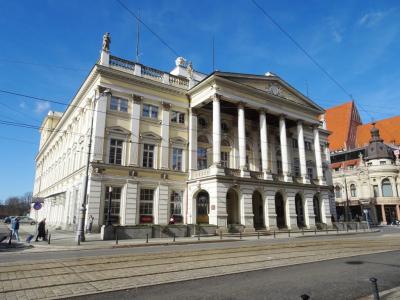
Opera Wroclawska (Wroclaw Opera House), Wroclaw
The Wrocław Opera, situated in the historic Old Town of Wrocław, holds a significant place in the city's cultural landscape. This opera company and its splendid opera house have a storied history dating back to 1841 when it first opened its doors to music enthusiasts. During its early years, from its inception until 1945, it bore the name "Oper Breslau," reflecting the city's German identity at the time.
The roots of opera in Breslau (now Wrocław) trace back even further. In 1725, the city witnessed the establishment of an Italian opera company under the leadership of Antonio Maria Peruzzi. This development followed a professional parting of ways between Peruzzi and Antonio Denzio, who had previously collaborated in the Peruzzi-Denzio company at the Sporck theatre in Prague.
A notable milestone in Breslau's operatic history occurred in 1755 when the "Theater on the Cold Ashes" was inaugurated by Franz von Schuch (1716–1764). This venue became a hub for opera performances, enchanting audiences with its musical offerings until von Schuch's passing in 1764.
The narrative of the Wrocław Opera underwent a transformative chapter following the conclusion of World War II and the shift of Breslau into Polish territory. It was on September 8, 1945, that the Lower Silesian Opera took its first bow in the newly christened Polish city of Wrocław. During the period from 1945 to 1950, the opera house expanded its scope beyond opera, accommodating theater, puppet theater, and operetta performances within its hallowed halls.
The roots of opera in Breslau (now Wrocław) trace back even further. In 1725, the city witnessed the establishment of an Italian opera company under the leadership of Antonio Maria Peruzzi. This development followed a professional parting of ways between Peruzzi and Antonio Denzio, who had previously collaborated in the Peruzzi-Denzio company at the Sporck theatre in Prague.
A notable milestone in Breslau's operatic history occurred in 1755 when the "Theater on the Cold Ashes" was inaugurated by Franz von Schuch (1716–1764). This venue became a hub for opera performances, enchanting audiences with its musical offerings until von Schuch's passing in 1764.
The narrative of the Wrocław Opera underwent a transformative chapter following the conclusion of World War II and the shift of Breslau into Polish territory. It was on September 8, 1945, that the Lower Silesian Opera took its first bow in the newly christened Polish city of Wrocław. During the period from 1945 to 1950, the opera house expanded its scope beyond opera, accommodating theater, puppet theater, and operetta performances within its hallowed halls.
Want to visit this sight? Check out these Self-Guided Walking Tours in Wroclaw. Alternatively, you can download the mobile app "GPSmyCity: Walks in 1K+ Cities" from Apple App Store or Google Play Store. The app turns your mobile device to a personal tour guide and it works offline, so no data plan is needed when traveling abroad.
Opera Wroclawska (Wroclaw Opera House) on Map






Sight Name: Opera Wroclawska (Wroclaw Opera House)
Sight Location: Wroclaw, Poland (See walking tours in Wroclaw)
Sight Type: Attraction/Landmark
Guide(s) Containing This Sight:
Sight Location: Wroclaw, Poland (See walking tours in Wroclaw)
Sight Type: Attraction/Landmark
Guide(s) Containing This Sight:
Walking Tours in Wroclaw, Poland
Create Your Own Walk in Wroclaw
Creating your own self-guided walk in Wroclaw is easy and fun. Choose the city attractions that you want to see and a walk route map will be created just for you. You can even set your hotel as the start point of the walk.
Wroclaw Introduction Walking Tour
Wroclaw, the capital of Poland’s Lower Silesia province, is a travel gem for wandering hearts. Steeped in over 1,000 years of history and a vibrant blend of Polish, German, and other cultural influences, it could easily compete for the title of the most beautiful city in Europe.
The area around Wroclaw was inhabited as early as the 9th century by Slavic tribes. The town was originally part of... view more
Tour Duration: 2 Hour(s)
Travel Distance: 3.7 Km or 2.3 Miles
The area around Wroclaw was inhabited as early as the 9th century by Slavic tribes. The town was originally part of... view more
Tour Duration: 2 Hour(s)
Travel Distance: 3.7 Km or 2.3 Miles
Cathedral Island Walking Tour
Cathedral Island, known as "Ostrów Tumski" in Polish, is a historic and enchanting district in the heart of Wroclaw. This picturesque island, nestled amid the Oder River, is a treasure trove of architectural and cultural wonders that date back centuries.
Begin your journey by crossing the iconic Tumski Bridge. It's not just a pathway but a symbol of love, as couples often attach... view more
Tour Duration: 1 Hour(s)
Travel Distance: 0.7 Km or 0.4 Miles
Begin your journey by crossing the iconic Tumski Bridge. It's not just a pathway but a symbol of love, as couples often attach... view more
Tour Duration: 1 Hour(s)
Travel Distance: 0.7 Km or 0.4 Miles


